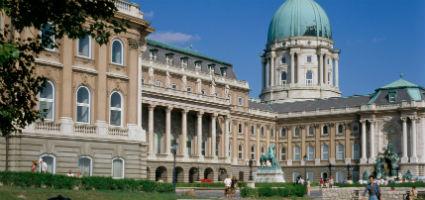2024. April 24. Wednesday
Hungarian National Gallery - Budapest
 |
Address: 1014, Budapest Szent György tér 2.
Phone number: (1) 201-9082
E-mail: info@mng.hu
Opening hours: Tue-Sun 10-18
|
The exhibition has closed for visitors.
2008.05.24. - 2008.08.04.
Museum tickets, service costs:
|
Individual ticket for adults
|
3200 HUF
|
/ capita
|
|
Individual ticket for students
|
1600 HUF
|
|
|
Individual ticket for pensioners
|
1600 HUF
|
/ capita
|
|
Video
|
1000 HUF
|
The sculptor who died last year, Tamás Fekete, bestowed his last artwork that can be considered as his main work, entitled "Honour to Brunellesch" is made up of 13 small statues. The museum is extremely grateful for the donation. They wish to present their gratitude by showing it to the audience.
The "Renaissance Year" s a good opportunity for the exhibition at building "A" of the National Gallery, where another exhibition provides an appropriate framework for the presentation of artworks related to King Mathias. The Brunellesch cycle by Tamás Fekete were born out of understood time- and the spirit requesting continuation.
Tamás Fekete worked as if he wanted to provide concise picture of his art. He turned to Renaissance, more precisely the beginning of Renaissance architecture as he realised that in the iconography rewriting the tools and structure of Brunellesch he can reterm the experiences of his youth. At the same time, he could fulfil his mission as an artist in the work resolutions where structures, machines are represented.
This thirteen "tool" statues are proofs of a brave and successful choice. They prove with their existence that work done with responsibility requires the honesty of spirit and hand. This process of work is able to both recall and recreate the "great, old times" in the present.
When remembering the art of Filippo Brunelleschi (1377-1446) memories of a journey to Florence, illustrations of an oeuvre-album played crucial role. Besides, the life of the great artist also influenced the cycle. The figure of the artist who began his career as a goldsmith, who designed fortresses and constructed them, the engineer can be seen as that of the figure of Tamás Fekete who studied in the workshop of Béni Ferenczi and was a demanding artist all his life.
Technical skill that characterised Brunellesch and was typical of Italian art for centuries is nowadays interesting from the point of view of science and technology history. Tamás Fekete quotes from models, sketch books, tracts and essays the way that he also reconstructs and constructs at the same time. Punctual "quotations" signify his knowledge of theories while scale models, mobile structures placed on unified medal props are "rewritings", "new versions" where the original function is either recovered or hidden. They are both logical and absurd, mechanised constructions."
Tibor Wehner
The "Renaissance Year" s a good opportunity for the exhibition at building "A" of the National Gallery, where another exhibition provides an appropriate framework for the presentation of artworks related to King Mathias. The Brunellesch cycle by Tamás Fekete were born out of understood time- and the spirit requesting continuation.
Tamás Fekete worked as if he wanted to provide concise picture of his art. He turned to Renaissance, more precisely the beginning of Renaissance architecture as he realised that in the iconography rewriting the tools and structure of Brunellesch he can reterm the experiences of his youth. At the same time, he could fulfil his mission as an artist in the work resolutions where structures, machines are represented.
This thirteen "tool" statues are proofs of a brave and successful choice. They prove with their existence that work done with responsibility requires the honesty of spirit and hand. This process of work is able to both recall and recreate the "great, old times" in the present.
When remembering the art of Filippo Brunelleschi (1377-1446) memories of a journey to Florence, illustrations of an oeuvre-album played crucial role. Besides, the life of the great artist also influenced the cycle. The figure of the artist who began his career as a goldsmith, who designed fortresses and constructed them, the engineer can be seen as that of the figure of Tamás Fekete who studied in the workshop of Béni Ferenczi and was a demanding artist all his life.
Technical skill that characterised Brunellesch and was typical of Italian art for centuries is nowadays interesting from the point of view of science and technology history. Tamás Fekete quotes from models, sketch books, tracts and essays the way that he also reconstructs and constructs at the same time. Punctual "quotations" signify his knowledge of theories while scale models, mobile structures placed on unified medal props are "rewritings", "new versions" where the original function is either recovered or hidden. They are both logical and absurd, mechanised constructions."
Tibor Wehner